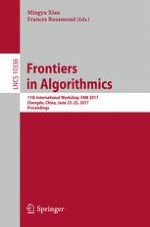2017 | Book
Frontiers in Algorithmics
11th International Workshop, FAW 2017, Chengdu, China, June 23-25, 2017, Proceedings
Editors: Mingyu Xiao, Frances Rosamond
Publisher: Springer International Publishing
Book Series : Lecture Notes in Computer Science
